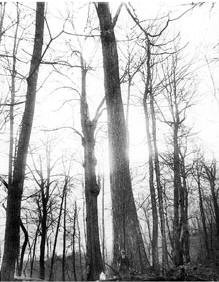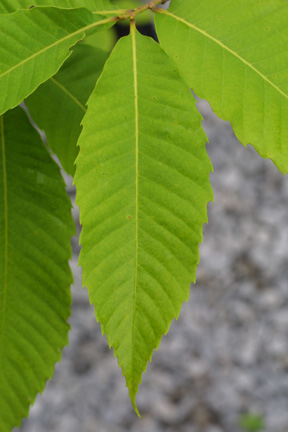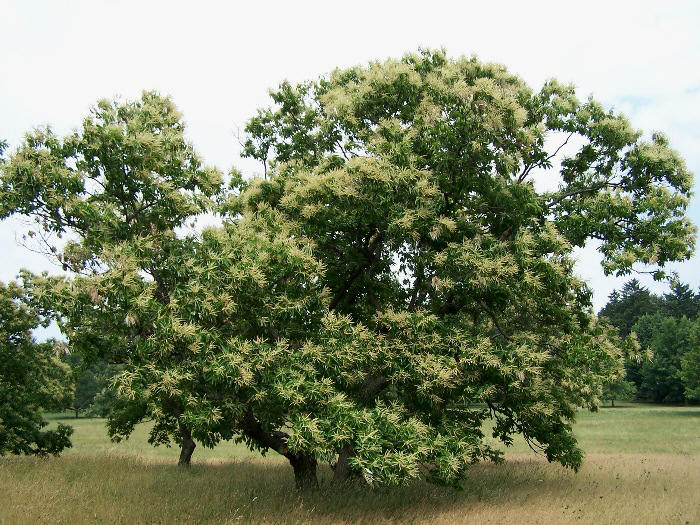Yum...glucose...
Well, like most of you already know, plants are autotrophic and use light energy as a means of producing complex organic compounds, such as glucose, from simple inorganic molecules, also known as photosynthesis. Those that are autotrophic are the producers and at the bottom of the food chain of all ecosystems.
Castanea dentata is best grown on rich, well-drained, slightly acidic soil in full sun. It is possible for it to prosper in nutritionally poor soils, yet the plant prefers light (sandy), medium (loamy) and heavy (clay) soils. It requires dry or slightly moist soil but is especially drought tolerant. Chestnut trees have a preference for slightly acidic or neutral soils however is also tolerant of highly acidic areas. It is also feasible for C. dentata to grow in semi-shaded or no shade woodlands but will tend to rank higher than almost any other tree in competitive ability and consequently rise above to obtain the sun's energy. All in all, this tree will grow on a variety of soils-except wet ones-ranging from loose sand and decomposed shale to dry, rocky ridges and mountain slopes, but does not succeed as well on limestone.
So, how did a giant like the chestnut tree transport food from the leaves down and transport water from the roots up? Well, I'm glad you asked because I'm a recent expert thanks to Organismal Biology...
Evaporation of water from the leaves of the tree is termed transpiration which leads to a reduced water potential of the mesophyll (middle) cells of the leaves. The removal of water in turn increases solute concentration. Because of this increased concentration of ions, water within the xylem (specialized transport cells) moves into the mesophyll cells (down the concentration gradient of water). The movement of water out of the xylem reduces the water pressure which results in the drawing of water into the vessels from the roots. Water will continue to flow up the xylem as a response to transpiration and also as a result of :
-
Adhesion: water molecules have a high affinity for other polar molecules such as the cellulose of cell walls
-
Cohesion: since water is highly polar, the molecules have a high tendency to adhere to one another resulting in a water column (chain of water molecules) that is difficult to break
-
Tension: water tension contributes to capillary action, which is the tendency for water to be drawn into smaller tubes up the tree
Therefore, water is pulled up the length of the tree from the roots by properties of the xylem and of water, itself.
CARBOHYDRATE TRANSPORT: Phloem
The phloem is specialized cells that comprise the transport system of carbohydrates, or glucose, obtained from photosynthesis by the leaves. Transport of sugars cannot be through the same tissues as water. Water movement occurs outside a cell, called apoplast movement, until it crosses the membrane from high to low water potential. Sugar movement is through sieve-tube members, cells that hold carbohydrates and water and are connected by plasmodesmata. Through unidirectional movement, sugar is transported between cells through a plasmodesma, also known as symplast movement. The theory lying behind carbohydrate transport is the Mass Flow theory, or pressure flow theory. It is thought that water flows in from nearby xylem when solute concentration is high by osmosis, creating pressure in the cells. Continuous transportation relies on draining sugar off along the path (sink) and adding sugar constantly by photosynthesis (source). In order to achieve the flow of sugars into sieve tubes with already high concentrations, active transport is utilized, with the requirement of ATP contributed by companion cells. In summary, the osmotic potential difference between a cell of high solute concentration and one with low solute concentration, creates bulk flow pressure which is relieved by the movement of solutes, or glucose, out of that cell into another. There is constant movement of carbohydrates from source to sink, whether that direction being up to the top of the tree, or down to the stump. Phloem cells transport glucose from areas with a continuous source to cells that serve the purpose to grow, store or metabolize. For instance, developing leaves act as a sink until photosynthesis begins, then will act like a source.
Continue on to learn about the birds and the bees...of chestnut trees, of course.
Feel free to check out other students' pages as well as our University's website below:


